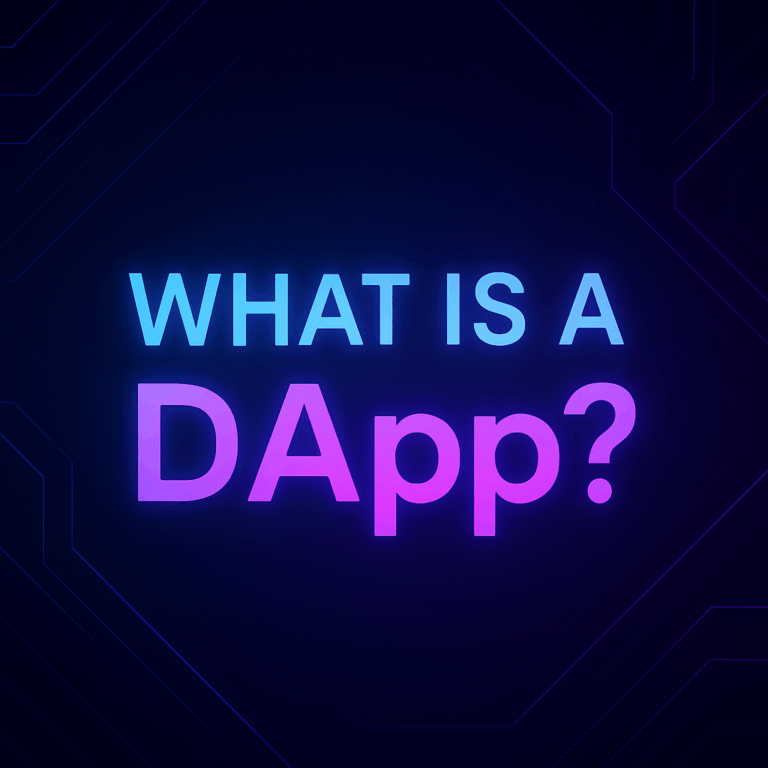
our blogs
What is DApp? Complete Guide to DApp Development | UNCW3B

What is a DApp? The Next Generation of Apps for Blockchain
As Web3 technologies become more popular, the DApp (Decentralized Application) is one of the most talked-about ideas. But what is a DApp, really? What makes it different from regular apps, and why do people think it’s one of the most important parts of the future internet?
In this guide, we will talk about the following:
- What DApps are
- How they came to be
- What makes them unique
- Their pros and cons
- How they are used in the real world
- What the future might hold
What is a DApp?
A decentralized application (DApp) is one that runs on a blockchain network instead of being hosted on servers that are all in one place. DApps work on a distributed peer-to-peer system where no one person has full control, unlike regular apps that depend on a company’s infrastructure.
A DApp connects users directly with blockchain networks without intermediaries.
To put it simply:
- Your Instagram, WhatsApp, or online banking app is centralized.
- Uniswap, Aave, and OpenSea are all decentralized platforms.
Smart contracts are the most important technology that makes DApps work. Smart contracts are digital agreements that run themselves and automatically follow the rules when certain conditions are satisfied. This means that banks, attorneys, and corporate servers don’t need to be involved. Today, DApps are redefining how users interact with Web3 — from finance to gaming and social platforms.
Learn more about decentralized applications (DApps) on the official Ethereum website
A Short History of DApps
When blockchain first appeared, the idea of decentralized apps quickly followed. Bitcoin was the first decentralized system, but it had just one purpose: sending money without needing to trust a middleman. It showed people that they could interact online without relying on banks or third parties.
Then came Ethereum in 2015, and this was a game-changer. With the addition of smart contracts, developers could now build decentralized programs that went beyond simple payments. This opened the door to an entirely new wave of applications.
The ICO and DApp boom happened in 2017. Decentralized games like CryptoKitties and early DeFi platforms suddenly caught the public’s attention.
In the summer of 2020, which is sometimes termed DeFi Summer, the next important milestone came. Decentralized finance took off, bringing in billions of dollars and showcasing what these apps can really do.
NFTs and blockchain games were the biggest hits from 2021 to 2023. Digital art, collectibles, and play-to-earn games didn’t stay in the crypto fringe; they became part of mainstream society. Suddenly, it wasn’t just investors who were interested; artists, gamers, and regular people wanted to be part of it too.
People say that we entered the Web3 era in 2024. And it doesn’t seem like things are going to slow down any time soon. DApps are far faster, more flexible, and more networked than they used to be. They don’t have to be on just one blockchain anymore. Instead, they run on many networks and leverage layer-2s like Arbitrum and Optimism to handle millions of users at once.
What began as simple tests has grown into ecosystems worth billions of dollars. The money is not the only part of the narrative, though. It’s about how the internet is changing — going from centralized platforms to being more decentralized and in the hands of the individuals who use it.
Main Parts of a DApp (Core Features)
For something to be a DApp, it usually needs:
- Going away from centralization – It doesn’t run on business servers; it runs on the blockchain.
- Open Source – The code is generally published to be clear.
- Making tokens – Uses native tokens to pay, reward, or control.
- Openness – All activities are stored on-chain.
- Not being able to censor – No one can easily turn it off.
How DApps Work (A Simple Breakdown)
A decentralized application (DApp) is essentially the same as any other piece of software that you use on a daily basis; yet, it is comprised of certain essential components that enable it to function on the blockchain.
- Smart contracts can be thought of as the rules of the app. On blockchains such as Ethereum, Solana, or Polygon, they are written directly onto the cryptocurrency. There is no way to alter them once they have been set up because they operate on their own.
- An example of a user interface (UI) would be the screen of a mobile application or a website that you can view and interact with.
- Wallet Integration: In order to use the software, you do not need to log in using an email address; rather, you must link your cryptocurrency wallet (MetaMask, Trust Wallet, Coinbase Wallet, or any similar wallet).
- Transactions: The blockchain maintains a record of every operation that you carry out, including voting, sending, and trading.
Different Types of DApps
There is a wide variety of decentralized applications (DApps), each of which fulfills a distinct function.
- Such as Aave, which allows for lending and borrowing, and Uniswap, which allows for trading.
- NFT platforms are marketplaces that let users to buy and sell digital collectibles. Examples of such marketplaces include OpenSea and Blur.
- Gaming decentralized applications (DApps) are games like Axie Infinity that let players to receive rewards simply by playing the game.
- A social decentralized application (DApp) is a decentralized social network, such as Lens Protocol.
- Governance decentralized applications (DApps) are forms of decentralized autonomous organizations (DAOs) that enable communities to vote and make decisions collectively.
DApps: Why Should You Use Them? (Advantages are)
- There is no single point of failure at any time.
- One of the benefits of blockchain technology is its transparency.
- Control of the User: You are the owner of your data and assets.
- Global Access Available to anyone who has access to the internet.
- NFTs, decentralized finance, and the metaverse are all powered by new economies.
- There is no need to rely on banks or governments whenever you use trustless systems.
DApps: Obstacles to Overcome and Their Limitations
Despite all the hoopla, decentralized applications (DApps) still have issues:
- The presence of an excessive amount of traffic causes things to move more slowly.
- Because of the gas fees, Ethereum can be quite expensive.
- Wallets and transactions are difficult to understand for newbies to the platform.
- Security risks: contracts that are poorly written are susceptible to being hacked.
- The lack of clarity around regulations: governments are still trying to figure it out.
Examples of Distributed Applications in Real Life
- DEXs, loans, and stablecoins are all examples of finance.
- Artists selling non-fictional works (NFTs) directly to fans are considered to be collecting artists.
- In the gaming industry, players can win actual prizes.
- Managing digital identities in a secure manner is the focus of identity and privacy.
- Providing transparent product tracking across the supply chain.
- Social media refers to platforms that do not have a centralized authority.
- When it comes to healthcare, safe preservation of medical records.
- Education: Blockchain-based diplomas and certifications.
What Will Happen to DApps in the Future?
Experts think that the next ten years will be very different:
- A better user experience: wallets that work properly and apps that perform well on phones.
- Layer-2 Scaling: Transactions that cost less and happen faster.
- Cross-chain Apps: DApps that can run on more than one blockchain.
- AI Integration: systems that are smarter and more adaptable because they are decentralized.
- A lot of people are using it: schools, businesses, and governments are all getting engaged.
- Hybrid Models: They combine the benefits of centralization with the safety of decentralization.
Last Thoughts on DApps
DApps are not merely “blockchain apps.” They show a change in how we utilize the web. Users may finally take charge of their data and assets instead of companies.
Whether you’re interested in finance, art, gaming, or just want to know what the future of the internet will look like, knowing about DApps is a must if you want to grasp Web3. They’re not perfect yet, but they’re changing the way we use the internet.
At UNCW3B, we explore how DApps, Web3, and blockchain are shaping the next era of the internet.

